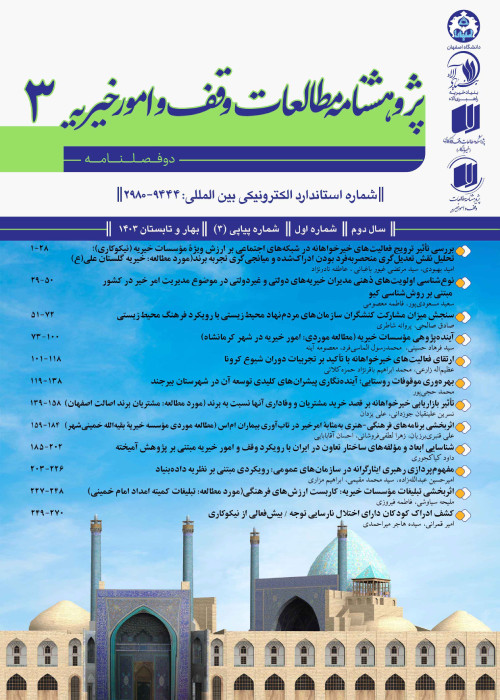Productivity of Rural Endowments: Foresight of Key Drivers for their Development in Birjand County
The paper discusses the enduring nature of endowments as a charitable institution, emphasizing both its spiritual and material significance. It highlights the increased importance of endowment capital investment in today's pursuit of a better life, as it can serve as capital for the development of social and geographical space (Hajipour et al., 2019).
The efficient utilization of endowments is described as an economic, social, and geographical necessity. The approach of futurism is emphasized as essential for optimizing decision-making and planning processes (Aliakbari, et al., 2018), as it allows for a scientific understanding and evaluation of the future (Coates, 1985). The paper concludes by stating that a futurist approach has been adopted to analyze the key factors for the development of endowments in rural areas of Birjand County, to increase their productivity and strengthen their role in the local economy.
This study is of an applied (decision-oriented) type. In terms of the execution process, it is considered mixed research. By conducting documentary studies, interviewing experts, and completing quantitative questionnaires, data and necessary information have been prepared for the research. To ensure the validity and increase the reliability of the data, a diverse sample approach (including managers, employees, and endowment beneficiaries) was adopted in the selective sampling stage, and ultimately the findings and prepared report have been reviewed and confirmed by participating experts in the research. In this study, both the Delphi method and cross-impact matrix analysis using MICMAC software have been utilized.
The total of documentary studies and the collection of informed opinions in the field of rural endowments in Birjand County identified 14 propositions (drivers) using the Delphi method. Among the influential factors (drivers) for improving rural endowment productivity, factors such as "process improvement and strengthening the role of local managers in institutional affairs," "facilitating access to advanced technologies," "increasing the level of education, especially digital literacy," "selecting knowledgeable and skilled individuals as custodians," and "consultation of beneficiaries with experts and specialists" were mentioned.
After identifying the influential factors, the "impact intensity" scores of each factor within the framework of the cross-impact matrix (using the MICMAC software environment) were assessed based on the degree of influence and susceptibility between 0 and 3. The number 0 indicates "no effect," the number 1 indicates "weak effect," the number 2 indicates "moderate effect," and the number 3 indicates "strong effect." Based on the obtained output, the matrix dimensions were 14*14, and the number of repetitions was considered to be 3. The matrix saturation index was 9.92%, indicating that in over 92% of cases, factors had an impact on each other.
Furthermore, out of a total of 182 relationships, 69 relationships, equivalent to 38%, had strong cross-impacts (3),
64 relationships, equivalent to 35%, had moderate cross-impacts (2), and 49 relationships, equivalent to 27%, had weak cross-impacts (1). Based on this, relationships with "strong" impacts had a higher frequency than other relationships.
According to the direct impact matrix, the sum of the rows of the matrix indicates the level of influence, and the sum of the columns indicates the level of susceptibility of a factor to other factors. The assessment of direct influence and susceptibility of influential factors in rural endowment productivity in Birjand County showed that in terms of influence, factors such as "financial support for small-scale beneficiaries through mechanisms such as microcredit funds (financial support)," "establishment of endowment-centered rural development groups (development group)," and "increase in the level of education, especially digital literacy (literacy)" were at the highest level. In terms of susceptibility, factors such as "development of strategic and competitive crop cultivation (competitive production)," "dominance of an economic management approach at all levels (economic approach)," and "facilitating access to advanced technologies (technology)" were at the highest level.
Based on the opinions of local experts and the results obtained regarding the influential factors on rural endowment productivity in Birjand County, it can be inferred that the situation is somewhat unstable, and the current conditions governing the system will change soon.
From the study carried out to identify the key drivers effective in improving and enhancing the productivity of rural endowments in Birjand County, it can be concluded that influential drivers include process improvement, knowledgeable individuals, development groups, consultation, and financial provision. These findings are consistent with the studies of Karimi (2000), Omidiani (2000), Sajadi Jazi (2015), and Ebadie (2009). Additionally, the only susceptible driver in the system map was technology, as the provision and equipment of technology necessary for rural endowments require resources that can be obtained through the benefits of productivity. In other words, these factors have mutual influence, which can create benefits through productivity and can also contribute to self-healing with the benefits derived from endowment productivity.
Finally, limited access of beneficiaries and custodians to financial resources on the one hand and the lack of knowledge of individuals in implementing modern changes on the other hand have been identified as serious obstacles. Planners and policymakers in the region can consider creating microcredit funds and endowment-centered rural development groups in their decision-making. The outcome of this study suggests the following recommendations:Given the seriousness of the issue of low productivity of rural endowments and the observed cases, it is necessary to eliminate the principle of competition and develop scenarios and corresponding implementation plans using the identified drivers in this study over a 5, 10, and 15-year time horizon.
Economic consultants familiar with current activities should be employed in the local endowment and charity offices, or experts from universities should be utilized through memorandums of understanding with provincial universities.
For the short-term and temporary period, financial resources should be allocated to the Provincial Endowments and Charity Administration (without being conditioned on the income of rural endowments) to support the development and equipment of technology and infrastructure expansion in rural settlements with endowments.
Economic activities and productive advantages should be determined for each district, and endowment beneficiaries should be encouraged to move towards them.
- حق عضویت دریافتی صرف حمایت از نشریات عضو و نگهداری، تکمیل و توسعه مگیران میشود.
- پرداخت حق اشتراک و دانلود مقالات اجازه بازنشر آن در سایر رسانههای چاپی و دیجیتال را به کاربر نمیدهد.



